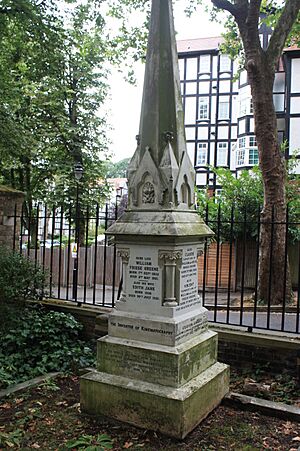Claude Friese-Greene facts for kids
Claude Friese-Greene (born May 3, 1898 – died January 6, 1943) was a British film expert. He worked as a cinema technician, filmmaker, and cinematographer. He is most famous for his 1926 collection of films called The Open Road.
Contents
Who Was Claude Friese-Greene?
Claude was born Claude Harrison Greene in Fulham, London. His father was William Friese-Greene, who was a very important person in early filmmaking. William helped create some of the first movie cameras.
Claude was also the grandfather of Tim Friese-Greene, who is a musician and music producer.
Claude died in Islington, London. He is buried with his parents in Highgate Cemetery.
Bringing Colour to Movies
Claude's father, William, started working on a way to add colour to films. This method was called Biocolour. It tried to make movies look like they had real colour. It did this by showing each other frame of a normal black-and-white film through two different coloured filters. Then, every other frame of the printed film was coloured red or green.
Even though Biocolour films looked somewhat colourful, they had some problems. Just like another famous colour process called Kinemacolor, Biocolour often flickered. This flickering could even cause headaches! Also, fast-moving things on screen sometimes had red and green edges around them. To try and fix these issues, films were often shot faster than usual.
Improving Colour Film Technology
After his father William passed away in 1921, Claude Friese-Greene kept working on the colour film system during the 1920s. He changed its name first to Friese-Greene Natural Colour and then to the Spectrum Colour Film process.
Claude became a highly respected cinematographer. He worked on more than 60 films between 1923 and 1943. He was also one of the first people to shoot films using Technicolor in Britain. Sadly, he died in January 1943 because of an accident while filming at the Denham Film Studios.
The Open Road: A Colourful Journey
In 2006, the BBC showed a TV series called The Lost World of Friese-Greene. This series, presented by Dan Cruickshank, included The Open Road. This was Claude Friese-Greene's film about his road trip across Britain in the 1920s, from Land's End to John o' Groats.
The Open Road was filmed using the Spectrum Colour Film process. The British Film Institute later used computers to improve the images. This helped to reduce the red and green edges around things that moved quickly in the film.
Films in Amazing Colour
Here are some films made using the Spectrum Colour Film process:
- Dance of the Moods (1924) – This film featured a modern dancer named Margaret Morris.
- Moonbeam Magic (1924)
- Quest of Colour (1924)
- The Open Road (1924–1926) – This film was restored by the British Film Institute in 2005.
Learn More
- Color motion picture film
- List of color film systems


